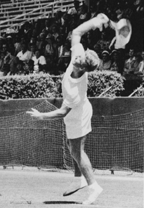|
TennisOne Lessons

Part 2: The Lew Hoad Serve -
The Power Game From Down Under
Jim McLennan, Senior Editor, TennisONE
See Part One
See animation of Hoad serve.
In Part One, we examined the classic Hoad serve and discussed
other servers who whipped the face the racquet across the ball, giving them
extra power and serving accuracy. In this lesson, we'll discuss why you
should snap across the ball rather then up and over. The answer has to do
with leverage and with the size and shape of the serving window.
Leverage
As you read this take your hands away from the keyboard
and turn them palm up. Then quickly turn palm down, and back and forth.
This is forearm rotation, and has nothing to do with the wrist. Now imagine
a racquet in your right hand, or you can use a long pencil. If the pencil
points out at a right angle from your forearm, when you rotate your forearm
the pencil will swing from right to left. For maximum leverage the pencil
(or other lever such as a racquet) should be at a 90 degree angle. Now take
the pencil and point it straight forward in line with your forearm and when
you rotate your forearm the pencil will not move but only spin. In this
case when the pencil is in line with the forearm, rotation does not produce
any appreciable leverage. So if the racquet is directly in line with
your arm and forearm at contact (from trying to serve up and over the ball)
you will achieve no leverage and power from forearm rotation. But
if the racquet is at an angle from your forearm, then rotation of the arm
will create additional racquet speed. And as Wayne Dyer says in his audiotapes,
"people you really need to know this!"
The Serving Window

Stand on the baseline and visualize the space above the
net through which a successful serve would pass. That window is about 18"
high and at least 108" wide. That is, there is much more room east
to west than north to south. When serving you are swinging quite fast, with
a loose whippy action. If you don't hit the ball just right, you will spray
it too high, too low or wide to one side or the other.
  Now if
you swing up and over the ball and snap the racquet in that direction, you
are accelerating the racquet within the 18" target zone. If you
swing up and then across, as Hoad does here, you are actually accelerating
within the 108" target zone, and there is much more room for error
within this aspect of the window. Now if
you swing up and over the ball and snap the racquet in that direction, you
are accelerating the racquet within the 18" target zone. If you
swing up and then across, as Hoad does here, you are actually accelerating
within the 108" target zone, and there is much more room for error
within this aspect of the window.
Howard Brody, in an excellent book entitled Tennis Science
for Tennis Players calculates the angular acceptance (margin of error)
of the racquet and ball at service contact. For a serve hit from a reasonable
height (100 inches) at a good rate of speed (90 mph) Brody calculates 2
degrees of vertical acceptance. That is, as the racquet touches the ball
on a successful serve (since the window is 18 inches high) the contact point
may deviate only one degree north and or one degree south, more than that
and the serve will go either into the net or long. Further, he calculates
10 degrees of horizontal acceptance, so from the perfect contact the racquet
may deviate 5 degrees to the east and or 5 degrees to the west of this spot
and still go in.
Now watch Hoad again and look for the swinging across rather
than up and over the ball. This actually increases his control, for the
racquet acceleration moves entirely within this horizontal window.
But don't try this one at home, consult your local USPTA
professional to learn the nuances and feel of this particular serve. And
if you are really serious about learning this, then go to the local gym
and enroll in a badminton league. The badminton clear is an overhead shot
where the intent is to send the shuttlecock as deep as possible into the
opponents court. And the clear looks and feels exactly like the Hoad service
action.
Send email to the author
We encourage you to email your comments (pro, con, appreciative, whatever)
directly to the author. To send email to Jim McLennan, click
here.
Go To:
Back to TennisONE Home Page
What's New | Tennis
Lessons | Tennis
in Your Area
Tennis Fitness | Tennis
Products | Sponsors/Advertisers/Consultants
webmaster@tennisone.com
TennisONE© is a trademark of TennisONE© and SportsWeb ONE©.
Copyright© 1995. All rights reserved.
|